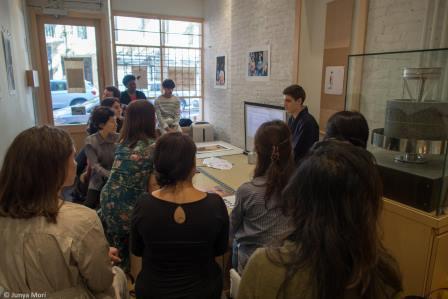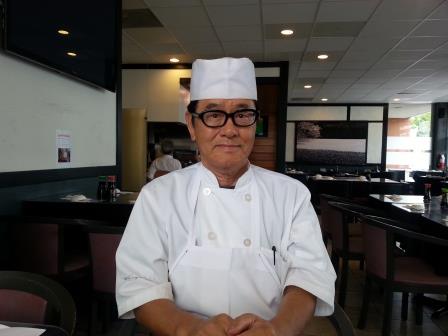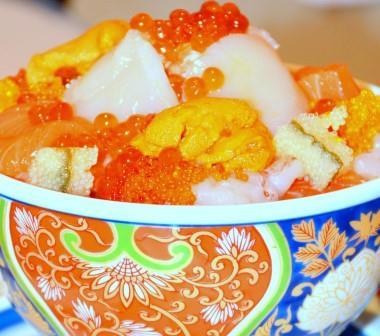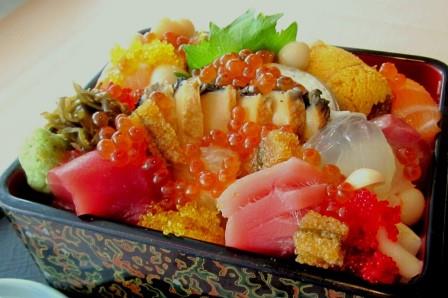De-omakase style community-based sushi restaurant opens
By Elli Sekine / Eri Shimizu
New Japanese cuisine projects have been more and more diversified each year, and the trend of the sushi business of the last few years has been high-end omakase style. However, in the Polk Street area where the rent is relatively cheap, there are many restaurants and bars with unique concepts run by young owners and entrepreneurs, which can be enjoyed casually thanks to the reasonably pricing. In this highly hopeful-prospect area, “Kuma Sushi and Sake” recently opened by a collaboration of a Japanese chef and an American chef. They declare “De-omakase style”, which is a rapidly increasing trend, and aim for creating a locally-loved casual dining place. In only 2 months from the opening, they already have earned regular customers.
The co-owners/chefs, Ryo Sakai and Cory Jackson, hit it off with each other while being trained under the same chef, and have worked together in a few other local area restaurants such as “Blow Fish”. After that, the experience in a project they planned together, a popup called “Pink Zebra” made a huge impact on deciding to open this restaurant. Ryo has been living in the Bay Area since his parents moved there from Japan when he was 4 years old. While he was working part-time in a Japanese restaurant during his school years, he was promoted to the kitchen staff, and it opened his eyes to the joy of making sushi. On the other hand, Cory was influenced by his father who loved to cook, and hoped to become a chef at a young age. He was trained in a local Japanese restaurant, and then moved to the Bay Area. He continued his training there in the kitchens of Aqua and Zuni Café.
Once stepped into the restaurant, a natural and modern space opens up, and gray walls and white wood interior under a high ceiling especially attract your attention. Behind the sushi counter on the right are various bottles of famous brand sakes. The interior artwork, murals by a local artist, and the logo by a friend, etc., show their concept of connecting to the local community and crafsmanship. Their “Getas (sushi plate/stand) are hand-made using California wine barrels, with which Ryo fell in love with, and specially custom-ordered them. The Geta’s adequately curved shape and naturally stained color gives a special feeling.
Their particularity about the menu is to offer the freshest, seasonal fish at reasonable prices. In San Francisco, where many sushi restaurants already exist and new restaurants keep opening, it is not easy to survive without being distinctively different from others. In order to be different, they came up with the idea of limiting the numbers of menu items and tables, but increasing the local repeat customers. In order to achieve that, many ingenious ideas are used in choosing the distributors, menu items, and even the operation system. For the fish, multiple distributors are used, depending on whether the fish is local or from Japan. For the drinks, whether sake or wine, each category is narrowed down to only 1 or 2 brands. There are no small bottles of sake, and sake is served by a carafe or by a glass poured from big bottles. It is cost-effective not to carry small bottles which take up a lot of storage space. The reason for carrying both sake and wine is for better paring with different sushi. They recommend “Tojikan” made of 100% Yamada-nishiki. The “Sake Flight” with 3 kinds of sake ($14) is also popular. They plan to change the brands periodically. In order to make good rotations by eliminating empty tables, they do not take reservations. You have to wait at the waiting bar area until your table becomes available while drinking and snacking.
Besides the main a-la-carte dishes, there are popular items such as the chef’s special which is the “5 kinds of sashimi plate” ($32), “4-piece nigiri sushi” ($16), and “8-piece nigiri sushi” ($32). The average cost per person with a drink is about $60, which is pretty reasonable. Daily special sushi/sashimi menu items include traditional Edo-mae style sushi ingredients such as tai (Japanese sea bream) with konbu seaweed, marinated tuna, ocean eel, etc. They use red tuna, not fatty tuna, and use its center for sashimi or sushi, and flavorful outside for marinades.
In order to please people who are not familiar with raw fish, they have many original sushi rolls. The most popular roll is the “Hey Girl” ($14), which has tempura shrimp inside, and is topped with tuna and avocado. The secret of its popularity is to show the live shrimp to the customer right before tempura-frying it. They also offer items like vegetable sushi for vegetarians, to accommodate many customers of different preferences.
Both Ryo and Cory disclose that in the future, they would like to see the restaurant become a friendly neighborhood place which cherishes not only their customers, but also other nearby restaurants and businesses. I would like to continue to keep an eye on the future activities of this restaurant which should turn out to be a sustainable business model that raises community values.
脱・オマカセ、地域密着型寿司店がオープン
新しい日本食プロジェクトは年々多様化し、寿司はハイエンドな「オマカセ」がこの何年かの潮流となっている。ポークストリート界隈では、家賃が比較的安いこともあり、若いオーナーや起業家がチャレンジするユニークなコンセプトで手軽な価格で楽しめるレストランやバーが多いエリアだ。今後さらに注目を集めそうなこの地域に、日米の寿司シェフがタッグを組んだ寿司レストラン、Kuma Sushi and Sake が新しくオープンした。近年急増中の“脱、高級オマカセ寿司”を宣言、カジュアルで地元に愛される店作りを目指し、オープン2 ヶ月で早くも常連客を獲得している。
オーナーシェフのリョウ・サカイ氏とコーリー・ジャクソン氏は、同じシェフの元で修行をしていたことから意気投合し、その後市内の「Blow Fish」など数件の寿司店で共に働いてきた。特に今年まで協働していたポップアップ、「Pink Zebra」 での経験が今回の店のオープンに大きな影響を与えた。リョウ氏は両親とも日本からの移住で、4歳からベイエリア在住。学生の時、日本食レストランでアルバイトをしていた際、キッチンスタッフに抜粋され、寿司を握ることの楽しさに目覚めたという。一方ジャクソン氏は、料理好きな父の影響で幼い頃よりシェフを目指し、地元の日本食店で修行。その後ベイエリアに移りAquaやZuniCafe のキッチンでも修行を重ねた。
店内に一歩足を踏み入れると、ナチュラルモダンな空間が広がり、中でも高い天井にグレーの壁と白木が目を引く。右手の寿司カウンターの背後には各種名酒がずらりと並んでいる。インテリアは、ローカルアーティストによる壁画や友達がロゴを制作するなど、地域と繋がりとクラフト感を大切にしている。寿司を乗せるゲタはカリフォルニアワインの樽を使った手作りで、リョウ氏が特に気に入って特別に注文したらしい。絶妙な丸みと使い込んだ色合いが風合いを持たせている。
メニューのこだわりは、旬の最高の魚を手頃な価格で提供すること。もともと既存の寿司店が多い上に近年新規参入も続くサンフランシスコでは、他店との差別化なしでは生き残りは難しい。そこで考えたのが、アイテム数と席数を抑え、地元のリピーターを増やすという方向性だった。そのため仕入れ先からメニューの決定、運営システムまで様々な工夫をしている。魚はローカルのものと日本からの魚を中心に扱う業者を複数使い分け、ドリンクリストは酒、ワインともそれぞれのカテゴリーから1〜2種ずつに絞り込んでいる。酒は小瓶は置かず一升瓶で仕入れた物をカラフェとグラスで提供する。保管スペースを取る小瓶を置かないことでコスト削減となるという。酒もワインも選ぶポイントは寿司とのペアリング。おすすめの銘柄は山田錦を100%使用した「杜氏鑑」。3種の酒フライト($14)も人気がある。今後銘柄は定期的に入れ替えていく予定。空席を減らし回転率をあげるため、予約はとらない。客は席が空くまで店内のウェイティングバーでドリンクとつまみを楽しみながら待つ。
料理はアラカルトが基本だが、シェフおすすめの刺身5種盛り合わせ($32) や寿司4 貫($16) または8 貫($32) のセットも人気。価格は平均ドリンクを含んでも$60程度と手頃な価格設定だ。日替わりの寿司・刺身メニューには鯛の昆布締めやマグロの漬け、穴子など伝統的な江戸前ネタもある。マグロはあえてトロは置かず赤身のみだが、芯の部分はそのまま、外側は旨味が強いので漬けになど素材を活かす工夫をしている。生魚に抵抗のある客も楽しめるようにと、オリジナルのロール寿司の種類も多い。一番人気はエビの天ぷらを巻きマグロとアボカドをトッピングした「Hey Girl」($14)。揚げる前に客に生きたエビを見せるパフォーマンスも人気の秘密だ。またベジタリアン向きにも野菜寿司があり、様々な嗜好の客をターゲットにしている。
また、両氏は今後の店づくりとして、地元経済が発展するよう近隣の飲食店やほかのビジネスも「仲間」と意識する「地域作り」に貢献したいと語る。コミュニティの価値を上げる持続可能なビジネスモデルを掲げる同店の活動を注視していきたい。
Kuma Sushi and sake
1040 Polk St. at Post
San Francisco, CA 94109
(415) 962-7400
http://www.kumasf.com/
Tues – Thurs 11:30am to 2pm, 5:30pm to 10pm
Friday 11:30am to 2pm, 5:30pm to 11pm
Saturday 5:30pm to 11pm
Sunday 5:30pm to 10pm
Closed on Monday
New Japanese cuisine projects have been more and more diversified each year, and the trend of the sushi business of the last few years has been high-end omakase style. However, in the Polk Street area where the rent is relatively cheap, there are many restaurants and bars with unique concepts run by young owners and entrepreneurs, which can be enjoyed casually thanks to the reasonably pricing. In this highly hopeful-prospect area, “Kuma Sushi and Sake” recently opened by a collaboration of a Japanese chef and an American chef. They declare “De-omakase style”, which is a rapidly increasing trend, and aim for creating a locally-loved casual dining place. In only 2 months from the opening, they already have earned regular customers.
The co-owners/chefs, Ryo Sakai and Cory Jackson, hit it off with each other while being trained under the same chef, and have worked together in a few other local area restaurants such as “Blow Fish”. After that, the experience in a project they planned together, a popup called “Pink Zebra” made a huge impact on deciding to open this restaurant. Ryo has been living in the Bay Area since his parents moved there from Japan when he was 4 years old. While he was working part-time in a Japanese restaurant during his school years, he was promoted to the kitchen staff, and it opened his eyes to the joy of making sushi. On the other hand, Cory was influenced by his father who loved to cook, and hoped to become a chef at a young age. He was trained in a local Japanese restaurant, and then moved to the Bay Area. He continued his training there in the kitchens of Aqua and Zuni Café.
Once stepped into the restaurant, a natural and modern space opens up, and gray walls and white wood interior under a high ceiling especially attract your attention. Behind the sushi counter on the right are various bottles of famous brand sakes. The interior artwork, murals by a local artist, and the logo by a friend, etc., show their concept of connecting to the local community and crafsmanship. Their “Getas (sushi plate/stand) are hand-made using California wine barrels, with which Ryo fell in love with, and specially custom-ordered them. The Geta’s adequately curved shape and naturally stained color gives a special feeling.
Their particularity about the menu is to offer the freshest, seasonal fish at reasonable prices. In San Francisco, where many sushi restaurants already exist and new restaurants keep opening, it is not easy to survive without being distinctively different from others. In order to be different, they came up with the idea of limiting the numbers of menu items and tables, but increasing the local repeat customers. In order to achieve that, many ingenious ideas are used in choosing the distributors, menu items, and even the operation system. For the fish, multiple distributors are used, depending on whether the fish is local or from Japan. For the drinks, whether sake or wine, each category is narrowed down to only 1 or 2 brands. There are no small bottles of sake, and sake is served by a carafe or by a glass poured from big bottles. It is cost-effective not to carry small bottles which take up a lot of storage space. The reason for carrying both sake and wine is for better paring with different sushi. They recommend “Tojikan” made of 100% Yamada-nishiki. The “Sake Flight” with 3 kinds of sake ($14) is also popular. They plan to change the brands periodically. In order to make good rotations by eliminating empty tables, they do not take reservations. You have to wait at the waiting bar area until your table becomes available while drinking and snacking.
Besides the main a-la-carte dishes, there are popular items such as the chef’s special which is the “5 kinds of sashimi plate” ($32), “4-piece nigiri sushi” ($16), and “8-piece nigiri sushi” ($32). The average cost per person with a drink is about $60, which is pretty reasonable. Daily special sushi/sashimi menu items include traditional Edo-mae style sushi ingredients such as tai (Japanese sea bream) with konbu seaweed, marinated tuna, ocean eel, etc. They use red tuna, not fatty tuna, and use its center for sashimi or sushi, and flavorful outside for marinades.
In order to please people who are not familiar with raw fish, they have many original sushi rolls. The most popular roll is the “Hey Girl” ($14), which has tempura shrimp inside, and is topped with tuna and avocado. The secret of its popularity is to show the live shrimp to the customer right before tempura-frying it. They also offer items like vegetable sushi for vegetarians, to accommodate many customers of different preferences.
Both Ryo and Cory disclose that in the future, they would like to see the restaurant become a friendly neighborhood place which cherishes not only their customers, but also other nearby restaurants and businesses. I would like to continue to keep an eye on the future activities of this restaurant which should turn out to be a sustainable business model that raises community values.
脱・オマカセ、地域密着型寿司店がオープン
新しい日本食プロジェクトは年々多様化し、寿司はハイエンドな「オマカセ」がこの何年かの潮流となっている。ポークストリート界隈では、家賃が比較的安いこともあり、若いオーナーや起業家がチャレンジするユニークなコンセプトで手軽な価格で楽しめるレストランやバーが多いエリアだ。今後さらに注目を集めそうなこの地域に、日米の寿司シェフがタッグを組んだ寿司レストラン、Kuma Sushi and Sake が新しくオープンした。近年急増中の“脱、高級オマカセ寿司”を宣言、カジュアルで地元に愛される店作りを目指し、オープン2 ヶ月で早くも常連客を獲得している。
オーナーシェフのリョウ・サカイ氏とコーリー・ジャクソン氏は、同じシェフの元で修行をしていたことから意気投合し、その後市内の「Blow Fish」など数件の寿司店で共に働いてきた。特に今年まで協働していたポップアップ、「Pink Zebra」 での経験が今回の店のオープンに大きな影響を与えた。リョウ氏は両親とも日本からの移住で、4歳からベイエリア在住。学生の時、日本食レストランでアルバイトをしていた際、キッチンスタッフに抜粋され、寿司を握ることの楽しさに目覚めたという。一方ジャクソン氏は、料理好きな父の影響で幼い頃よりシェフを目指し、地元の日本食店で修行。その後ベイエリアに移りAquaやZuniCafe のキッチンでも修行を重ねた。
店内に一歩足を踏み入れると、ナチュラルモダンな空間が広がり、中でも高い天井にグレーの壁と白木が目を引く。右手の寿司カウンターの背後には各種名酒がずらりと並んでいる。インテリアは、ローカルアーティストによる壁画や友達がロゴを制作するなど、地域と繋がりとクラフト感を大切にしている。寿司を乗せるゲタはカリフォルニアワインの樽を使った手作りで、リョウ氏が特に気に入って特別に注文したらしい。絶妙な丸みと使い込んだ色合いが風合いを持たせている。
メニューのこだわりは、旬の最高の魚を手頃な価格で提供すること。もともと既存の寿司店が多い上に近年新規参入も続くサンフランシスコでは、他店との差別化なしでは生き残りは難しい。そこで考えたのが、アイテム数と席数を抑え、地元のリピーターを増やすという方向性だった。そのため仕入れ先からメニューの決定、運営システムまで様々な工夫をしている。魚はローカルのものと日本からの魚を中心に扱う業者を複数使い分け、ドリンクリストは酒、ワインともそれぞれのカテゴリーから1〜2種ずつに絞り込んでいる。酒は小瓶は置かず一升瓶で仕入れた物をカラフェとグラスで提供する。保管スペースを取る小瓶を置かないことでコスト削減となるという。酒もワインも選ぶポイントは寿司とのペアリング。おすすめの銘柄は山田錦を100%使用した「杜氏鑑」。3種の酒フライト($14)も人気がある。今後銘柄は定期的に入れ替えていく予定。空席を減らし回転率をあげるため、予約はとらない。客は席が空くまで店内のウェイティングバーでドリンクとつまみを楽しみながら待つ。
料理はアラカルトが基本だが、シェフおすすめの刺身5種盛り合わせ($32) や寿司4 貫($16) または8 貫($32) のセットも人気。価格は平均ドリンクを含んでも$60程度と手頃な価格設定だ。日替わりの寿司・刺身メニューには鯛の昆布締めやマグロの漬け、穴子など伝統的な江戸前ネタもある。マグロはあえてトロは置かず赤身のみだが、芯の部分はそのまま、外側は旨味が強いので漬けになど素材を活かす工夫をしている。生魚に抵抗のある客も楽しめるようにと、オリジナルのロール寿司の種類も多い。一番人気はエビの天ぷらを巻きマグロとアボカドをトッピングした「Hey Girl」($14)。揚げる前に客に生きたエビを見せるパフォーマンスも人気の秘密だ。またベジタリアン向きにも野菜寿司があり、様々な嗜好の客をターゲットにしている。
また、両氏は今後の店づくりとして、地元経済が発展するよう近隣の飲食店やほかのビジネスも「仲間」と意識する「地域作り」に貢献したいと語る。コミュニティの価値を上げる持続可能なビジネスモデルを掲げる同店の活動を注視していきたい。
Kuma Sushi and sake
1040 Polk St. at Post
San Francisco, CA 94109
(415) 962-7400
http://www.kumasf.com/
Tues – Thurs 11:30am to 2pm, 5:30pm to 10pm
Friday 11:30am to 2pm, 5:30pm to 11pm
Saturday 5:30pm to 11pm
Sunday 5:30pm to 10pm
Closed on Monday












